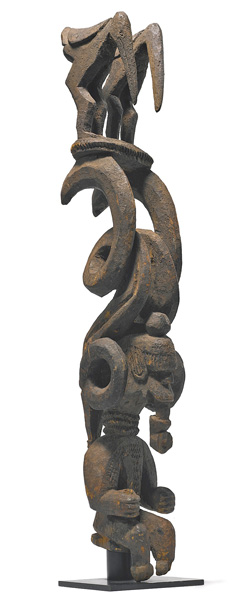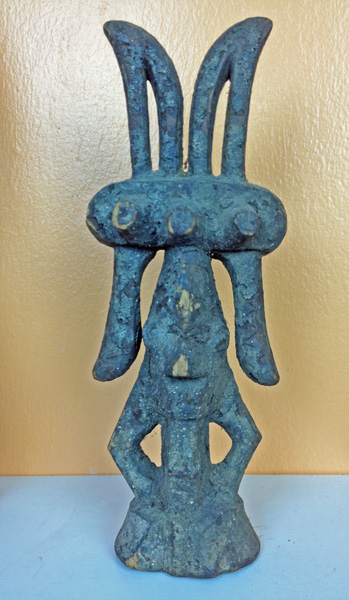Five Things one should know about Ikenga
November 20, 2014 5 Comments
What is Ikenga?
Ikenga is a ‘ritual object’ (commonly found in Igbo family shrines), which on an individual basis represents ‘masculine strength’ and the ‘ability to achieve one’s goals through one’s efforts’. [1]
Types of Ikenga
The Ikenga is in the image of a horned male figure made out of wood.
• In its simplest form, it consists of only a cylindrical block and projecting “horns”. The horn symbolizes the aggressive, assertive, and powerful nature of the male animal.
• The more elaborate type of Ikenga is a standing or seated male figure with a fully realized head and limbs which usually holds a machete in the right hand (hence “the cult of the right hand” – typically the hand of strength), and a severed head in the other.
• The very abstract ikenga represents “characteristic ikenga features, such as a stool for the seat of authority and horns for vitality”. [2]
Understanding Ikenga.
To understand and “map” the eastern Ikenga concept to western thinking I use the following :
• Igbo religion incorporates the concept of an all-powerful creator God, Chikwu. (also called Chineke). [3],[4]
• Chi has been described as a sub-deity functioning as a personal, spiritual guide, (which sounds like a Christian adaptation to the “guardian angel” (mmuo) hypothesis). [3],[4]
• Each person has a chi that represents the personality essence that controls one’s destiny. [5]
• “Ikenga sculpture reflects the traits defined by the ikenga (the spirit element) that is an aspect of a constituent part of the chi”. [5]
• “The ikenga is the force that facilitates personal achievement and propels individuals to success”. [5]
What is the Origin of Ikenga?
Scholars are divided into two groups. The first relate Ikenga to the Egyptian “ram headed” influence as part of Igbo history, while the second and more plausible line believes that “that the Ikenga cult did not diffuse from anywhere into Igboland; at best, it is that part of the Igbo religious culture, epitomized in the spirit force and the powers of the guardian angels exemplified in Chi, and expressed in varied forms, which controlled the individual’s destiny and day-to-day affairs”. [1]
Where is Ikenga Used?
Ikenga is primarily used by the Igbo, however it is also used by the Igala to the north (called Okega), and by the “Benin and Delta groups, bordering western Niger Igbo groups, who call theirs Ikengobo, Ivri etc. The Oji, Orji, Ogilisi, and Okwe trees are special types of trees, believed to have spiritual potency, and appear to be the trees used in carving the Ikenga. However, the Akanta tree, which is a very hard wood and highly revered by carvers and medicine men across Igboland, was also used”. [1]
[1] The Ikenga, as Emblem of Greatness in the Cosmology of the Igbo of Southeastern Nigeria, Ihediwa Nkemjika Chimee
[2]http://www.digitalgallery.emory.edu/luna/servlet/view/all/what/Ikenga+are+shrines+to+the+right+hand
[3] http://en.wikipedia.org/wiki/Chukwu
[4] http://nigeriaworld.com/articles/2009/may/242.html
[5] A Companion to African Philosophy, (edited by Kwasi Wiredu), p421
[E1] In Pursuit of Beauty, Sotheby’s (NY), 11/11/14
[E2]-[E4] Private Collection (AplusAfricanArt)





